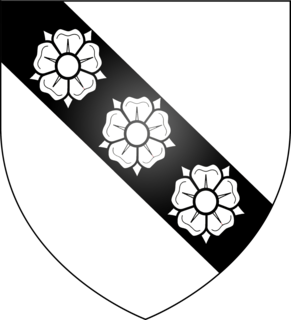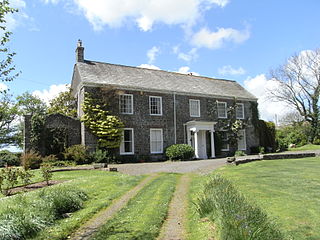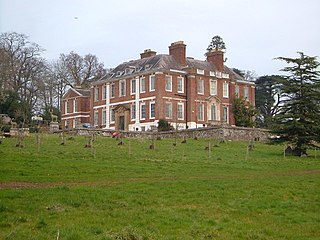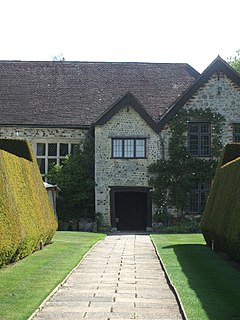
The Cary family is an English aristocratic family with a branch in Ireland. The earliest known ancestor of the family is Sir Adam de Kari who was living in 1198. Sir John Cary purchased the Manor of Clovelly in the 14th century and established the family's status as members of the landed gentry. Various branches of the family were ennobled in the late 16th and early 17th centuries as Baron Hunsdon and Viscount Falkland.

Hall is a large estate within the parish and former manor of Bishop's Tawton, Devon. It was for several centuries the seat of a younger branch of the prominent and ancient North Devon family of Chichester of Raleigh, near Barnstaple. The mansion house is situated about 2 miles south-east of the village of Bishop's Tawton and 4 miles south-east of Barnstaple, and sits on a south facing slope of the valley of the River Taw, overlooking the river towards the village of Atherington. The house and about 2,500 acres of surrounding land continues today to be owned and occupied by descendants, via a female line, of the Chichester family. The present Grade II* listed neo-Jacobean house was built by Robert Chichester between 1844 and 1847 and replaced an earlier building. Near the house to the south at the crossroads of Herner the Chichester family erected in the 1880s a private chapel of ease which contains mediaeval woodwork saved from the demolished Old Guildhall in Barnstaple.

The landed gentry and nobility of Devonshire, like the rest of the English and European gentry, bore heraldic arms from the start of the age of heraldry circa 1200–1215. The fashion for the display of heraldry ceased about the end of the Victorian era (1901) by which time most of the ancient arms-bearing families of Devonshire had died out, moved away or parted with their landed estates.

Ash in the parish of Braunton in North Devon is a historic estate listed in the Domesday Book. The present mansion, known as The Ash Barton estate is a Grade II* listed building.

Cofton is a small village, parish and former historic estate, near Dawlish in south Devon,

Langley was a historic estate in the parish of Yarnscombe, Devon, situated one mile north-east of the village of Yarnscombe. It was long the seat of a junior branch of the Pollard family of Way in the parish of St Giles in the Wood, Devon, 3 miles to the south.

Great Fulford is an historic estate in the parish of Dunsford, Devon. The grade I listed manor house, known as Great Fulford House, is about 9 miles west of Exeter. Its site was said in 1810 to be "probably the most ancient in the county". The present mansion house is Tudor with refurbishment from the late 17th century and further remodelling from about 1800. The prefix "Great" dates from the late 17th century and served to distinguish it from the mansion house known as "Little Fulford" in the parish of Shobrooke, Devon, about 8 miles to the north-east, also owned briefly by Col. Francis Fulford (1666–1700), as a result of his marriage to the heiress of the Tuckfield family. Great Fulford has been the residence of the Fulford family, which took its name from the estate, from the reign of King Richard I (1189–1199) to the present day. There are thus few, if any, families in Devonshire of more ancient recorded origin still resident at their original seat. In 2004 the estate comprised 3,000 acres.

Peamore is a historic country estate in the parish of Exminster, Devon, which is near the city of Exeter. In 1810 Peamore House was described as "one of the most pleasant seats in the neighbourhood of Exeter". The house was remodelled in the early 19th century and is now a grade II listed building.

Sir James Hamlyn, 1st Baronet (1735–1811) of Clovelly Court in Devon, and of Edwinsford, Carmarthenshire, Wales, was a Member of Parliament (MP) for Carmarthen 1793–1802. He served as Sheriff of Devon 1767-8. He was created a baronet in 1795. He not only inherited a large estate in Devon from his wealthy childless great-uncle, but also married a wealthy Welsh heiress.

Sir William Huddesfield of Shillingford St George in Devon, was Attorney-General to Kings Edward IV (1461–1483) and Henry VII (1485–1509). He built the tower of St George's Church, Shillingford.
The Manor of Clovelly is a historic manor in North Devon, England. Within the manor are situated the manor house known as Clovelly Court, the parish church of All Saints, and the famous picturesque fishing village of Clovelly. The parish church is unusually well-filled with well-preserved monuments to the lords of the manor, of the families of Cary, Hamlyn, Fane, Manners and Asquith. In 2015 the Rous family, direct descendants via several female lines of Zachary Hamlyn (1677–1759) the only purchaser of Clovelly since the 14th century, still own the estate or former manor, amounting to about 2,000 acres, including Clovelly Court and the advowson of the parish church, and the village of Clovelly, run as a major tourist attraction with annual paying visitor numbers of about 200,000.

Mohuns Ottery or Mohun's Ottery, is a house and historic manor in the parish of Luppitt, 1 mile south-east of the village of Luppitt and 4 miles north-east of Honiton in east Devon, England. From the 14th to the 16th centuries it was a seat of the Carew family. Several manorial court rolls survive at the Somerset Heritage Centre, Taunton, Somerset.

Thuborough in the parish of Sutcombe, Devon, England, is an historic estate, formerly a seat of a branch of the Prideaux family, also seated at Orcharton, Modbury; Adeston, Holbeton; Soldon, Holsworthy; Netherton, Farway; Ashburton; Nutwell, Woodbury; Ford Abbey, Thorncombe, all in Devon and at Prideaux Place, Padstow and Prideaux Castle, Luxulyan, in Cornwall. The present mansion house, comprising "Thuborough House" and "Thuborough Barton", the north-east block, is a grade II listed building.

Sir Hugh Stucley (1496–1559) was lord of the manor of Affeton in Devon, and was Sheriff of Devon in 1545. His third son was Thomas Stukley, known as "The Lusty Stucley".

The Manor of Upton Pyne is a former manor in the county of Devon, England. The manor included the village of Upton Pyne situated about 3 miles northwest of the historic centre of Exeter. The manor house is Pynes House.

Wortham is an historic manor within the parish of Lifton in Devon, England. The early sixteenth century manor house survives, today the property of the Landmark Trust. It was long the seat of the Dynham family, a junior branch descended from the Anglo-Norman magnate Baron Dynham. A mural monument survives in Lifton Church to John Dynham (d.1641) of Wortham, consisting of an escutcheon showing the arms of Dynham of Wortham impaling Harris of Hayne ) with the crest of Dynham above: An arm couped or hand azure holding a lock of hair sable, with an inscribed tablet beneath. John Dynham (d.1641) was the last in the male line and married Margaret Harris (d.1650), a daughter of Arthur Harris (1561-1628) of Hayne in the parish of Stowford and lord of the manor of Lifton, both in Devon, and of Kenegie in the parish of Gulval in Cornwall, Sheriff of Corwall in 1603 and Captain of St Michael's Mount, Cornwall. Arthur Harris's grandfather John Harris (d.1551) of Hayne, a Serjeant-at-Law and Recorder of Exeter, had purchased the manor of Lifton from the Nevile family, Earls of Northumberland. John Dynham (d.1641) died without children whereupon his heir was his niece Mary Hex, a daughter of his sister Margaret Dynham by her husband John Hex of Alternon in Cornwall, who married John Harris of Lifton, consequently Wortham passed to the Harris family.

Sir John Kirkham (1472–1529) of Blagdon in the parish of Paignton, Devon, was Sheriff of Devon in 1523/4. He was one of the Worthies of Devon of the Devonshire biographer Prince (d.1723), who called him a "very free and liberal, ... prudent and discreet" benefactor of the town of Honiton in Devon.

George Kendall (1610-1663), Doctor of Divinity, of Cofton in Devon, was a theologian.
Collacombe is an historic manor in the parish of Lamerton, Devon, England. The manor house survives as a grade I listed building, known as Collacombe Barton or Collacombe Manor (House).

Knightstone is an historic manor in the parish of Ottery St Mary in Devon. The surviving mediaeval and Tudor grade I listed manor house is situated one mile south-east of St Mary's Church, Ottery St Mary. It was the seat of the Bittlesgate family, the heiress of which Joan Bittlesgate, daughter of Thomas Bittlesgate by his wife Joan Beauchamp, was the wife of Richard Woodville, grandfather of Elizabeth Woodville (c.1437-1492) Queen consort of England as the spouse of King Edward IV. In 1381 the Bittlesgate family obtained a licence from the Bishop of Exeter to build and operate a private chapel at their home, but no trace of the structure survives. The house has been much altered since the time of the Bittlesgate family. One Tudor-era fireplace survives in a bedroom.




















